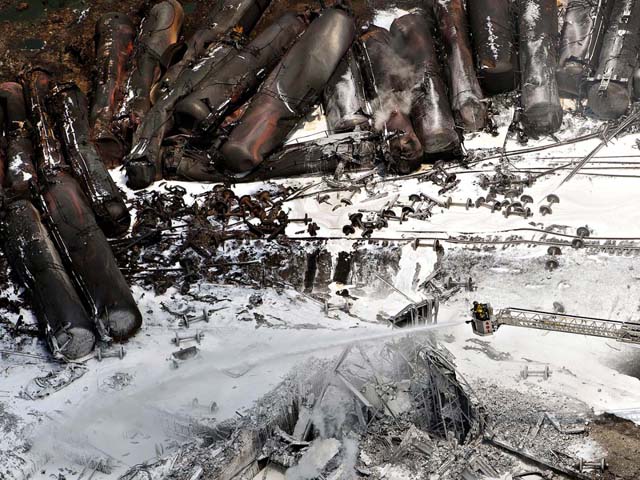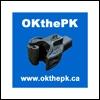

A fireman sprays foam on the derailed tank cars - Date/Photographer unknown.
1 August 2013 Authorities Want Closer Look at Highly Flammable Cargo in Lake Megantic Disaster Lake Megantic Quebec - The cargo that exploded in the centre of Lake Megantic appears to have been more flammable than regular crude oil, says the federal Transportation Safety Board as it sends the liquid for laboratory analysis.
The TSB said Thursday that it plans to take a closer look at the fluid that sloshed inside the railroad tankers that erupted into towering fireballs when the train derailed in the town.
The agency took samples of the liquid out of concern that the series of powerful blasts was much more intense than what might normally be expected from the petroleum product.
"I'm not an expert in this domain, but it seems that the crude oil reacted in an abnormal way," Ed Belkaloul told reporters in Lake Megantic.
"That's why we took samples, to know exactly what the ingredients are in this crude oil, and to know why the rail cars blew open like this."
The TSB wants to ensure that the goods involved in the fiery derailment were properly described and packaged in the right tankers.
A thorough examination of the train's crude comes amid debate over the potentially explosive characteristics of so-called shale oil.
The train that derailed in Lake Megantic on 6 Jul 2013, killing 47 people, was transporting crude from a large shale deposit in North Dakota known as the Bakken field.
Some shale oil has been found to contain hydrogen sulphide vapour, a flammable, corrosive, and highly explosive compound. Bakken crude is known to hold considerable amounts of flammable hydrogen sulphide gas.
The Lake Megantic crash came just a couple of months after pipeline company Enbridge Inc. presented documents to the U.S. Federal Energy Regulatory Commission stating that it refused to carry Bakken oil with extremely high levels of hydrogen sulphide in its lines.
The company explained to the commission that the sulphide posed a serious risk to the health and safety of workers that came into close contact with the substance.
In Canada, federal government regulation and safety standards do not distinguish between different types of crude oil, Keith Stewart of Greenpeace said in a recent interview.
He added that they are all labelled as Class 3 flammable liquids for transportation purposes, even though the chemical make-up could make one type more explosive than another. Stewart said the regulatory failure to distinguish between different types of crude could cost lives in the future.
But some don't believe different types of crude oil require separate and distinct classifications as dangerous goods.
Railway analyst Chris Damas of BCMI Research has said the composition of the oil is not a major safety concern, adding he believes that establishing separate regulations and rules for handling different types of crude would make little difference.
TSB investigator Donald Ross, who also took part in Thursday's Lake Megantic news conference, acknowledged that the Class 3 shipping designation includes a range of products.
"From a very thick, tarry, black, oily, type of petroleum product, crude oil and that sort, right down to the very, very, thin, light oils that are highly volatile and burn very fiercely, like jet fuels," Ross said.
He was later asked if the contents of the ill-fated Lake Megantic tankers might have contained a liquid stronger than jet fuel.
"We're not prepared to say anything at this point. What we want to say is we're checking that for everybody," he said. "We've taken samples of the product, we've sent it away for analysis, we're going to wait for the results of those analyses to understand exactly what the properties were."
"I think for most people that arrived on the site, they were quite surprised at the extent of the fire and the subsequent explosions that occurred."
Andy Blatchford.



Vancouver Island
British Columbia
Canada
| 

